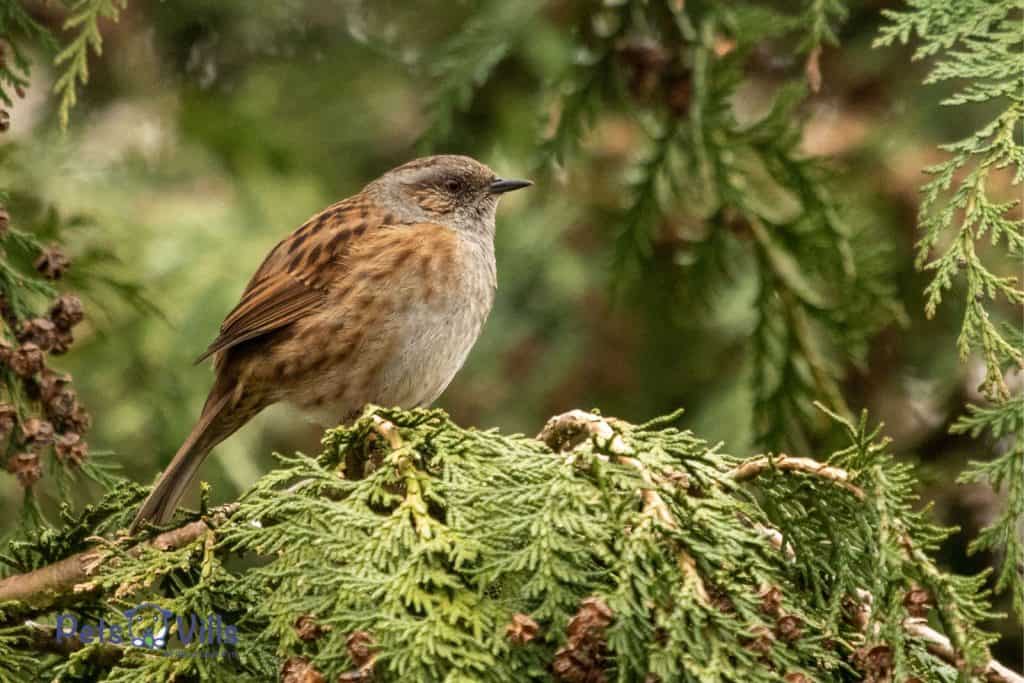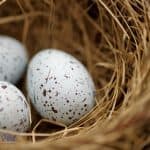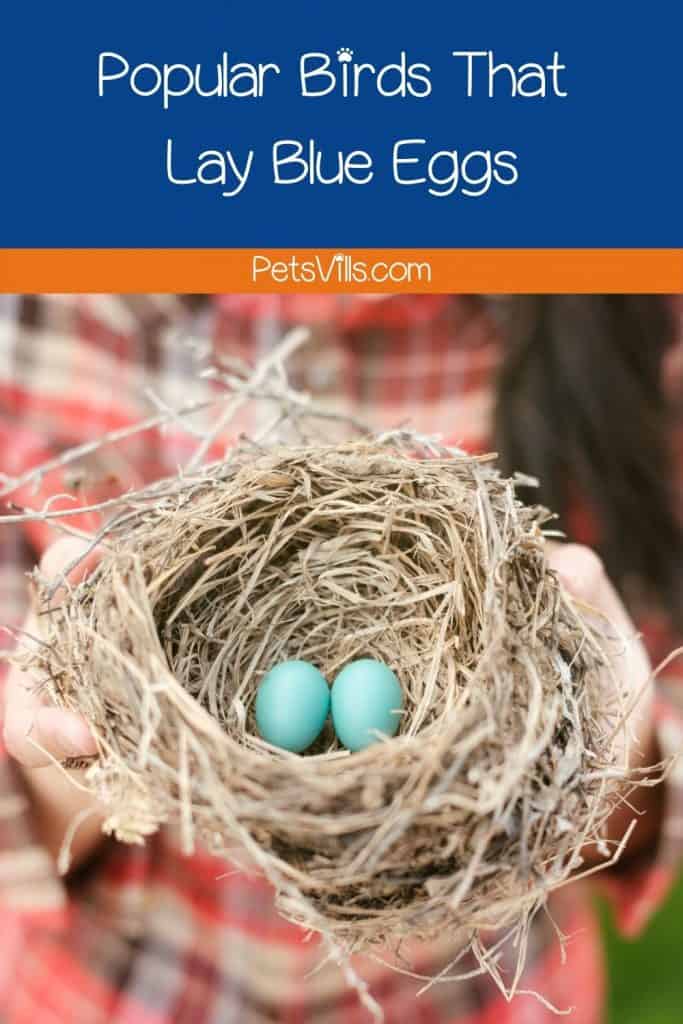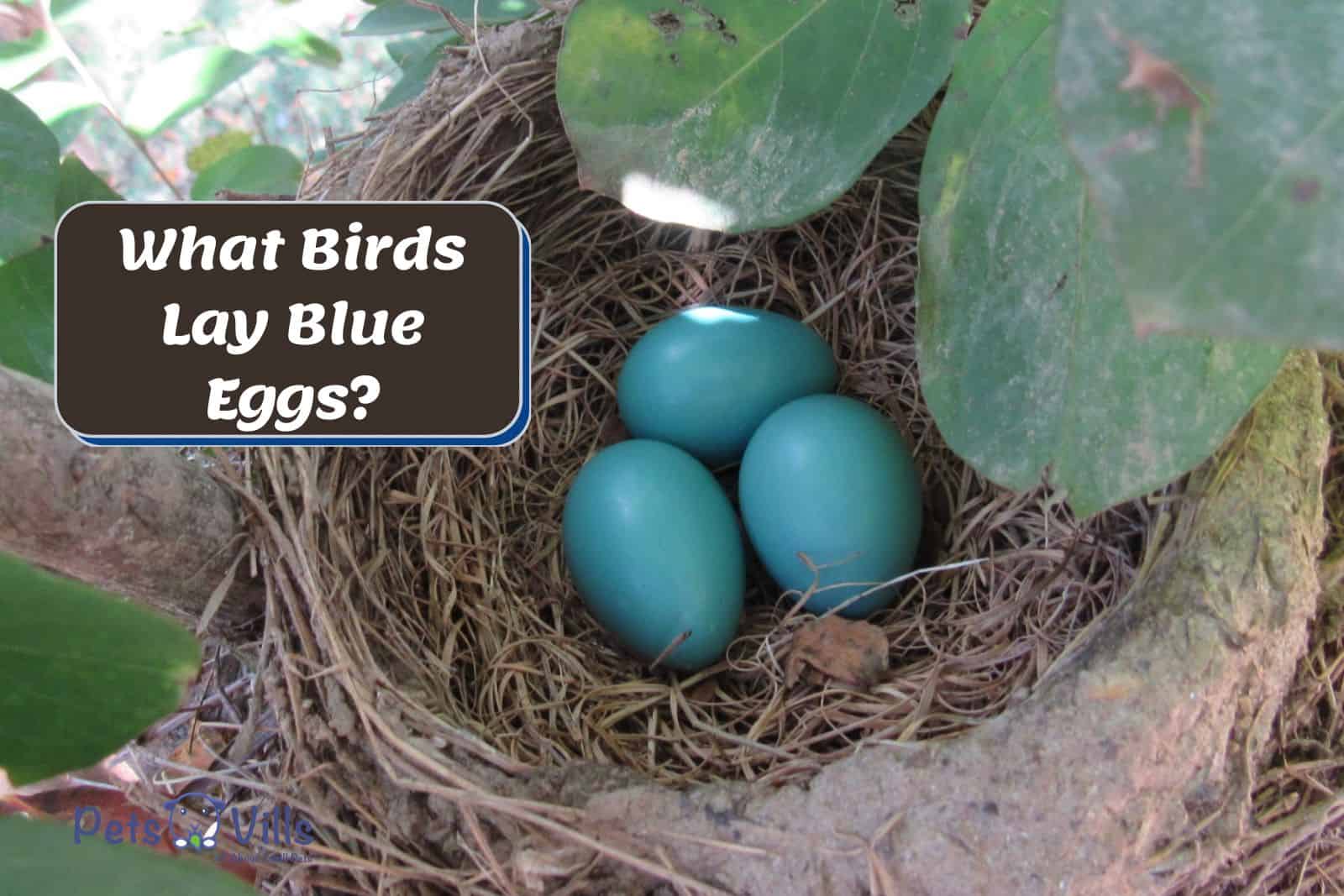Do you know what birds lay blue eggs? I didn’t either until I did some research! There are quite a few different types of birds that lay blue eggs, some of which are pretty surprising.
So if you’re wondering what color egg, your bird will lay, read on for a list of species that might surprise you!
Table of Contents
7 Birds That Lay Blue Eggs
1-Dunnocks

The Dunnocks bird is small and brown with a grey head. They’re about 14cm long, making them one of the smaller UK birds!
These silent creatures won’t make any noise for you – not even when they nest or feed; their movements are all that can be heard from this lively little creature.
They like to stay near hedges, parks, and bush gardens. Few of them stay in trees. The trees have to be thick and protected.
Dunnock feeds on insects, worms, seeds, and spiders since they have tiny beaks. They do not have a variety to feed on like other birds.
They are quiet, but when two males collide during breeding time, they are violent. The female and male dunnocks get along well, but the female can mate with any male.
The number of eggs differs, but they can lay up to five.
READ MORE: Do Birds Eat Mosquitoes?
2-Robin
Robins are one of the most familiar birds in North America, thanks to their bright red breasts.
But did you know that robins also lay blue eggs? The blue color comes from a pigment called biliverdin, which is also responsible for the color of a bird’s feathers [1].
So next time you see a robin’s egg, take a moment to appreciate all the beautiful colors of nature.
Check out this cool video!
3-Eastern Bluebird
The Eastern Bluebird is a beautiful bird that is native to North America. One of the most striking things about this bird is its blue eggs.
The eggs are a beautiful sky blue color and are usually laid in clutches of four or five. The bluebirds typically nest in abandoned woodpecker holes or other small cavities, often reusing the same nest year after year.
In addition to their beautiful eggs, the Eastern Bluebirds are also known for their cheerful song [2]. This song can often be heard in the springtime and is one of the surest signs that warmer weather is on the way.
For anyone who enjoys watching birds, the Eastern Bluebird is a species worth seeking out.
Here’s a video from a Bluebird nest cam.
4-Common Myna
The Common Myna is a species of bird that is native to southern Asia. The bird is easily recognizable by its black body and yellow beak.
One interesting fact about the Common Myna is that it lays blue eggs. The blue color of the eggs helps to camouflage them from predators.
The bird is also known for vocalizing, including imitating other birds and animals. The Common Myna is a popular pet bird in many parts of the world, and its ability to mimic sounds has made it a favorite among bird enthusiasts.
Check out these blue eggs.
5-Blue Jays
Did you know that blue jays lay blue eggs? That’s right – the same blue hue that distinguishes their beautiful feathers is also present in their eggs.
While the color of bird eggs can vary widely, blue jays are one of only a handful of species that sport this particular shade. So, why are their eggs blue?
One theory is that the color helps to camouflage the eggs from predators. Another possibility is that pigmentation protects the eggs from UV rays.
Regardless of the reason, it’s simply fascinating to think about how such a vibrant color can occur in nature!
6-Red-Winged Blackbird
The red-winged blackbird is a medium-sized bird that is native to North America. One of the most distinctive features of this bird is its striking red plumage.
Males have jet black feathers with bright red shoulders, while females are mostly brown with some red on their wings. Another interesting fact about the red-winged blackbird is that it lays blue eggs.
This is relatively rare among birds and is thought to help camouflage the eggs from predators. The red-winged blackbird is common in marshes and wetlands, where it can often be seen perching on reeds and grasses.
These birds are highly social creatures and often form large flocks when feeding or nesting. Thanks to their adaptability, the red-winged blackbird has a wide range across North America and is considered a common bird species.
7-House Finches
The house finch is a small songbird often found near human habitation. One of the distinguishing features of this bird is its brightly colored eggs.
The eggs are typically pale blue with brown speckles, and each clutch contains three to five eggs.
The female house finch incubates the eggs for about two weeks, and both parents help care for the young birds once they hatch.
The house finch is a relatively common bird and has been introduced to many parts of the world beyond its natural range. As a result, its blue eggs can be found in various habitats.
In addition to these few species of birds, many other species of birds lay blue eggs that you are unlikely to know about.
Here is a list of some of the familiar birds that lay blue eggs:
- Little Blue Heron, Great Blue Heron
- Gray Catbird
- Snowy Egret
- Song Thrush
- Magpies birds
- Sterling birds
- Aztec, Bicknell’s, Clay-colored, Dusky, Swainson’s, Varied,
- American, Fish, Hawaiian, and Tamaulipas Crow
- Red-winged, Rusty, and Tricolored Blackbird
- Lawrence’s, and Lesser Goldfinch
- Blue-footed Booby, Bluethroat, Blue-gray Gnatcatcher, Blue Grosbeak, Blue Mockingbird
- Eurasian Jackdaw, Eurasian Bullfinch
- Eastern, Western, and Mountain Bluebirds
- Snowy egrets
READ MORE: What Eats Birds?
Why Do These Birds Lay Blue Eggs?
Blue eggs are actually pretty common in the bird world. In fact, about one in four bird species lays blue eggs. There are a few theories about why this might be.
One is that blue light reflects more UV rays than other colors, making the eggs less visible to predators.
Another is that the pigment biliverdin, which gives eggs their blue color, is a natural antibiotic. This helps to protect developing chicks from bacteria and other infections.
Finally, it’s possible that blue eggs simply offer a camouflage advantage. After all, many nests are hidden away in dark places, and a blue egg will be much harder to spot than a white one.
Whatever the reason, blue eggs are just another example of the amazing diversity of the bird world.
FAQs
What month do birds lay eggs?

Most birds lay their eggs at this time from early spring to mid-summer. There are some species of birds that lay eggs twice a year.
Do birds feel pain when laying eggs?
Birds usually do not feel pain during laying. However, if it takes more time to lay eggs, the bird may feel discomfort.
Conclusion
So there you have it! We hope you’ve enjoyed learning about some of the most interesting egg-laying birds in the world.

Do you have a favorite? Let us know in the comments below!
Resources
- 1. CASSEY P, THOMAS GH, PORTUGAL SJ, et al. Why are birds’ eggs colourful? Eggshell pigments co-vary with life-history and nesting ecology among British breeding non-passerine birds. Biological Journal of the Linnean Society. 2012;106(3):657-672. doi:10.1111/j.1095-8312.2012.01877.x
- 2. Kight CR, Swaddle JP. Eastern Bluebirds Alter their Song in Response to Anthropogenic Changes in the Acoustic Environment. Integrative and Comparative Biology. 2015;55(3):418-431. doi:10.1093/icb/icv070
Deanna is a passionate animal lover. She is the mom of several guinea pigs and sugar gliders.
When she’s not writing, Deanna loves listening to country music, or watching Dancing With The Stars.
Read her : Latest Articles
FIND HER ON: FACEBOOK and LINKEDIN and


